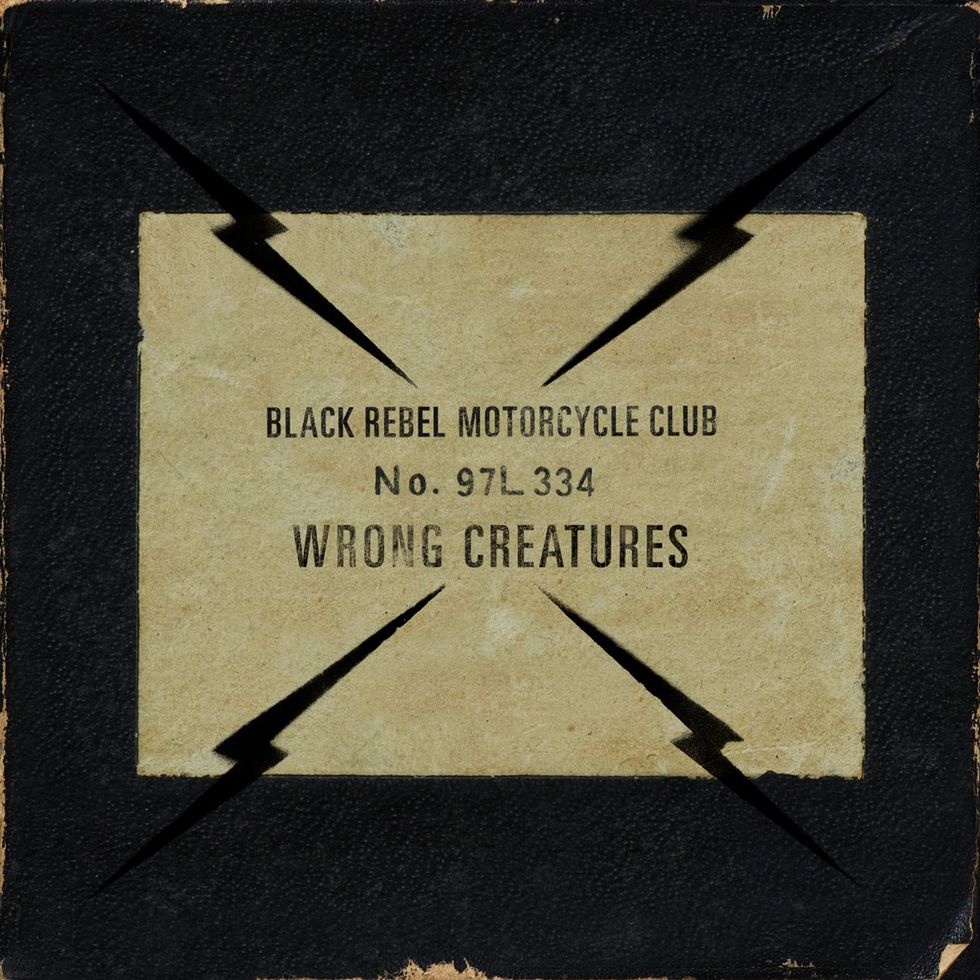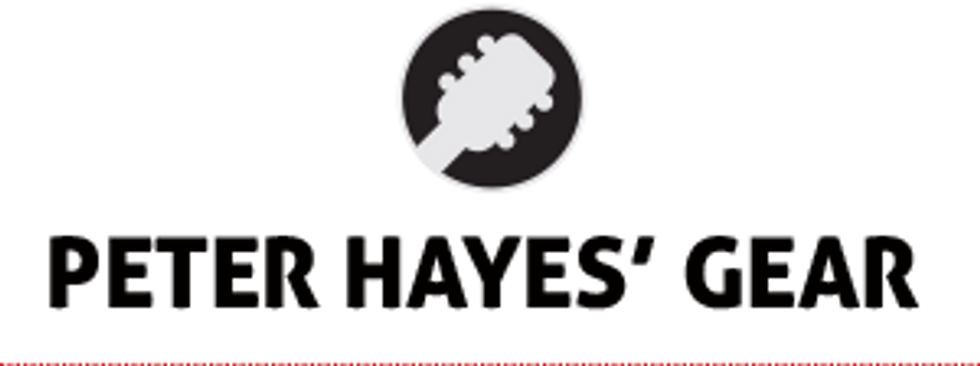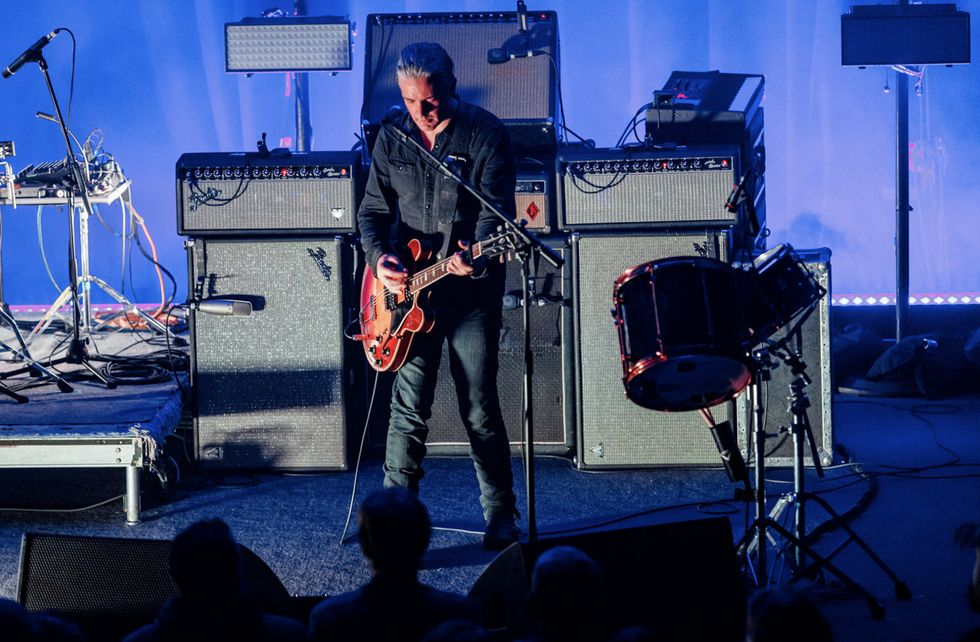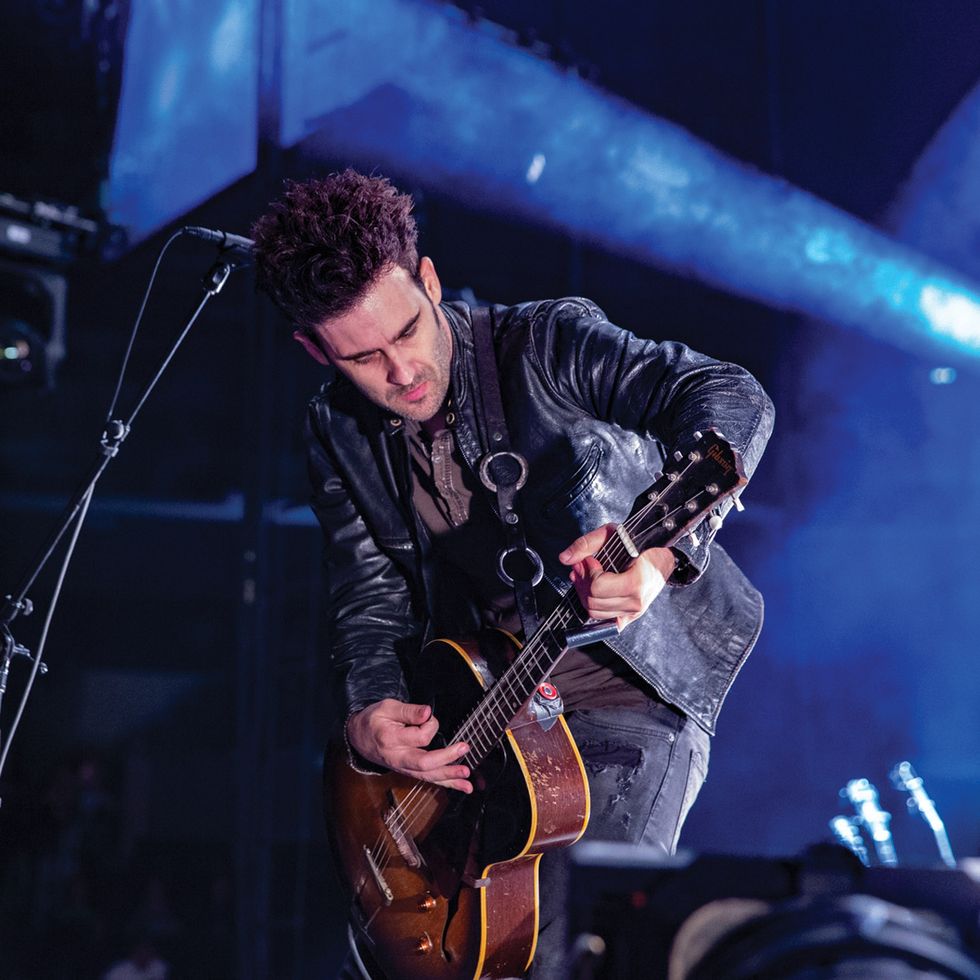It’s been a long road for Black Rebel Motorcycle Club. The band’s first album debuted in 2001, framing them as one of the bright lights of the rock ’n’ roll revival of the early aughts—part of the same class that included the White Stripes, the Strokes, and a cavalcade of other garage-y outfits that inflated the prices of pawnshop guitars while injecting the pop-oriented mainstream with a much-needed dose of bratty energy and sound. While many of BRMC’s peers dealt in shades of vapid retro posturing, the trio from the Bay Area possessed a moodiness and angry undertone that separated them from the pack.
As the band’s discography grew, the substance and nuance rooted in BRMC’s early work flourished in albums that leaned hard on acoustic elements, blues, a flair for subtle electronics, and effects-laden psych-rock. Now with the release of Wrong Creatures, their eighth album—and their first in more than five years—Black Rebel Motorcycle Club’s musical vision has matured into something altogether unique: a remarkably cohesive and timeless blend of the band’s many past selves that retains the piss and vinegar that earned the group its bones.
At the core of Black Rebel Motorcycle Club’s sound is the symbiotic musical relationship of co-frontmen and principle songwriters Robert Levon Been (the son of the late Call bassist and songwriter Michael Been) and Peter Hayes (formerly of the Brian Jonestown Massacre). Been typically handles bass, although he occasionally plugs an ancient Gibson archtop guitar into his bass rig, and Hayes plays guitar. However, it’s often hard to tell where Been’s sound ends and Hayes’ begins. The pair have spun an artform out of seamlessly weaving their unique playing styles to create a sound that is powerful, dynamic, and always propelled by an undeniably rock ’n’ roll attitude. Hayes’ guitar world is one of altered tunings, stereo rigs drenched in effects, and an interest in economy over fretboard histrionics. Been, on the other hand, shifts between treating his bass as a melodic instrument and a punishing, fuzz-drenched rhythm hammer—but always in service of the song. The pair, joined by drummer Leah Shapiro, have developed their styles almost entirely around the concept of three people making as much noise as possible. And with Wrong Creatures, one hears a band that has truly dialed in its identity and approach to guitar-based rock.
As the trio pulled into Brooklyn for a tour stop promoting its new release, Premier Guitar was granted an audience with the perpetually leather-clad Hayes and Been to discuss the writing and recording of Wrong Creatures, their unique brotherhood as musicians, the charms of vintage Gibson semi-hollow guitars and hollowbody basses, and how they go about corralling and taming their gigantic live rigs.
Robert, your live rig is massive and the sound you guys get live is almost combative in volume. How do you capture that sound in the studio?
Robert Levon Been: The studio’s very different for us. That ratty, overdriven sound I get live is something we can get in the studio with the old method of turning a small amp up really loud. Onstage, I tend to need as much power as possible—partially to compete with Pete’s rig, which gets bigger every year, but also to be able to fill the space in the room if I need to, and in a way I have a little control over.
—Robert Levon Been
How do you capture the sound of your complex stereo rig in the studio, Peter?
Peter Hayes: For the most part, once we’ve broken the song down to something out of a jam, I’ll bring the whole rig in and we’ll mike it up and do it live like that. I usually end up only keeping one track of the live rig and then doing some overdubs to get the stereo width I’m looking for. So I’ll do a lot of doubling tracks and panning them hard left and hard right. I like the sound of tracks played twice much more than faking a double track, where you copy and paste and nudge it in time a little. I’d rather just play over the top again. I’ve tried a bit of everything when doing overdubs, as far as amps go. A lot of it ends up going straight into the board. On the first record, it was all right into a Tascam board and trying to get a weird distortion out of that. So a lot of the guitars on this album are direct. I keep the amps in there for depth, but the direct signal thing works for us a lot.
Robert, what amps did you use for the bass tracks on Wrong Creatures?
Been: We used one of the SVT 8x10 cabs and an SVT 2PRO, but I also went direct a lot and tweaked the sound with plug-ins to dial in some specific tones. We did a hybrid of both a lot, which meant we weren’t committed to just what was coming out of the cabinet for the entire record.
In a three-piece, everyone has to be really hauling their weight and then some ... and then a little more after that! If we had had a second guitarist or a keyboardist from the beginning, the nature of my playing would be very different, because in those situations you can lay back and leave room for other people to do their thing. But as we are, there’s a lot to be done as a bass player. I do love the challenge, because it keeps the pressure on to be creative—not having extra support players—and it’s especially rewarding when you pull it off and find a unique way to make it work.

TIDBIT: To get the roiling guitar and bass sounds on their latest, Hayes and Been built their sonic foundation on small amps cranked up for natural breakup and distortion.
You constantly shift from lead work to rhythmic stuff. Tell us where you’re coming from as a bassist—what influences, beyond the necessities of a trio, went into developing your style?
Been: It always feels like it goes back to my grandmother, who was constantly humming something. When I was a kid, I’d always walk around humming melodies, kind of like a tic, but I think that’s why my brain always goes straight to melodic ideas—more like how guitar players probably think. So the bass has always felt like a natural extension of the melodies in my head.
Also, having a well-known songwriter and bassist for a father—who was something of a virtuoso—had a bit to do with it. He was much more technically gifted than I am, as I learned when I tried to pull off his parts for 20 songs in this Call tribute show we did. The forgiving thing about music is that you can do things in tricky ways or find your own way to do something, and the grand excuse is making it more about your own expression than technical skills ... which always applies.
And while I never really followed bassists, exactly, Peter Hook was a big one for me. I never really had bass heroes. It would be a song as a whole that moved me and that was a very sacred thing. So whatever I do is more to be in service to the song, whatever that may mean. And that’s what makes me push myself as a bass player or learn the guitar, just so I can get things out.
Peter, you’ve always cited guitar heroes like Hendrix as being really big influences, but you’ve never been one for lead guitar heroics. Can you explain where a Hendrix comes into your playing, since you’re more texture-oriented?
Hayes: Nick McCabe from the Verve was a big one, too. With Hendrix, I just loved that stuff so much I told myself it doesn’t need to be done anymore. There’s no fuckin’ way or reason to even bother trying to do anything like that, because it’s so singular. I never really got into the whole technical side of playing, or really learned how to play, in some sense. I got bored with the technical stuff so quickly that I just found my own thing.
My style stems from the fact that, when I first started playing, I didn’t understand that in a recording studio you play a part and then track another part on top of that. So, the only way I could figure it out was detuning the guitar in a way that allowed me to play a chord and then play licks over the top of that chord, so you have a rhythm and a lead going at the same time. That’s why I got into alternate tunings and have so many guitars on the road, but never really got much of the technical side of the guitar together. I never really learned how to play in standard tuning, and I still have a hard time figuring out other people’s songs.
Peter Hayes carries his own literal wall of sound to the band’s concerts, and mostly plugs a fleet of ES-335s into it. He generates his core tone through a pair of Fender Bandmaster heads. Photo by Matt Condon
One of my favorite tones on the album is the synth-y bass on “King of Bones.” How did you get that tone and how did that song come to be?
Been: The Electro-Harmonix Holy Grail pedal had a lot to do with the sound on that one. Once the riff came to me, I realized I was kind of in Bauhaus/Tones on Tail/Love and Rockets territory, and I really like that, and it’s been a really long time since we’ve done anything in that world.
The song kicked around for a long time while we tried to find that spirit and do our version of it, and after we recorded it in that style, it was very dry and boring, and probably the biggest disappointment on the whole album because I had such high expectations for it. It lost something in the initial recordings and I was about to throw it away, but then I started messing around with different synths and Moog melodies to go along with it, and give some counterpoint and movement, and I fell in love with it. It became a new song to me, and it had elements of what we were initially going for, but it was everything I had been wanting to push the band further towards doing.
Could you describe how your playing relationship with Peter has evolved over the years?
Been: Pete’s the best chance I have at being genuinely excited about a song in the way that you really can’t be when you’re the sole writer. A lot of people forget that we both bring our own things in, and while I might be playing a bass part on something that Pete wrote that belongs to the whole band, I’m also typically a nerdy superfan of his writing and obsessing over his songs. I love that half the record I get to just enjoy and be surprised by his writing, and that’s the best part about collaboration: You don’t have to spend so much time second-guessing yourself. Pete’s stuff moves me, and inspires me, and takes me to another place, which keeps my head in check in a lot of ways. My whole heart is fulfilled by writing music, but it’s so much better to experience it with that collaborative element, and especially so with someone like Peter, who I’m a true fan of.
Most of the time, the way we work is we’re such opposites—as people and in the way we approach music—that we typically fill in the spaces that are missing from each other’s approach. He comes from this hypnotic, tribal, simpler place, and I come from a more chord-based, traditional songwriter place, and he creates a very different musical space.

Guitars
Various Gibson ES-335s (including Michael Been’s late-’60s model)
Gibson SG Standard
Gibson SJ-200
Amps
Marshall 50-watt JMP head
Marshall 4x12 Cab
Two Fender Bandmasters
Two Fender 2x12 cabs
Fender Twin Reverb
Effects
G-Lab switching system
Radial Headbone Valve Tube Head Switcher
Klon Centaur
TC Electronic Dark Matter distortion
SansAmp PSA 1.1
TC Electronic G-Major
Akai Headrush
Strings and Picks
Dunlop (.013–.056, .013–.052 sets)
Dunlop Tortex 1.00 mm
Peter, same question.
Hayes: It’s kind of a funny battle with that, because there’s a lot of stuff that he does that’s up in a guitar’s sonic range, and he’s also flying around with distortions and such, so it always comes into play when we mix things. It gets tricky trying to find our spaces and figure out who should take over when and where, and we kinda just flip a coin sometimes when it comes to figuring out those dynamics. But yeah, a lot of the stuff he does is in the guitar range and it really makes me sound like I’m doing a lot more than I really am.
It’s hard to describe, but there’s so much unspoken stuff when it comes to us in a room jamming—where it just works through body language. At the end of the day, we just trust in each other and know when we trade things off, it works. It’s sort of an intuition, now. It’s not something that comes along very often and we try to respect that thing that we have and not take it for granted.
Robert, what effects are on your board?
Been: I mainly use pedals made by Dave Archer under the name Vintage FX: the Colordrive and VFX Overdrive. I also use the Electro-Harmonix Holy Grail and different delays like the Akai Headrush for looping stuff. I have a TC Electronic octave pedal that I use a lot, and I really like fucking around with just regular old Boss EQ pedals. People underestimate what those pedals can do when it comes to carving out tones on the fly when you’re playing, but also the extra little bit of drive you can get from one of those. I feel like when you use a Boss EQ to boost your signal, it sounds and feels more like driving a mixing board in the studio. I also need to use those EQs to run the archtop guitar into my Ampeg rig, because I’m changing between such drastic sounds, and I run my acoustic guitars through the Ampeg rig. If I don’t have an EQ pedal setup for each guitar, the whole thing roars and feeds back like crazy.
Peter, since your style relies heavily on stereo and big delays, do you write with effects in mind?
Hayes: It can be a little dangerous to rely too much on effects. That can kind of lie to you about how good a part is or if it’s actually a song. I’ve learned the hard way that sometimes you’ve got something that sounds great through the effects and you break it down on an acoustic and you realize you haven’t got much of a song. A lot of our songs start on acoustic guitar and we either leave them there or trick them out afterward, depending on the feeling they inspire.
When Been plugs his Gibson ES-150 into his massive bass rig, he uses equalization to tame screaming feedback and enhance the old hollowbody’s natural tonal character. Photo by Debi Del Grande
Robert, I really appreciate your dedication to Epiphone Rivoli and Gibson EB-2 semi-hollowbody basses. What do you really love about them?
Been: I can’t remember who it was, but I saw someone playing one live and thought it was just the coolest looking bass I’d ever seen. It was really just for the look when I first got into them, and I stumbled into a pawn shop in San Francisco and saw one for $650. I didn’t have that much, so I talked the guy down by pointing out things like, “It’s worn down here, and it’s scratched up here.” It was actually the things I liked most about the bass—the wear and tear—but he got nervous and I talked him down to, like, $500. That was the way it started. I learned and wrote on that bass forever, and it wasn’t until much later that I realized how different it was from other basses, being short scale and semi-hollow, and how much tighter it could sound. You walk the border of guitar tones with the way they resonate naturally, so there’s a lot of things going on with those basses that I didn’t realize when I first got it. And then, years later, I picked up a Fender P bass again and it was exhausting to play. It felt like holding a log or something.
Peter, you’ve played Gibson ES-335 semi-hollowbodies your entire career and have amassed quite a few. What draws you to them?
Hayes: In the very beginning, I had an acoustic guitar I’d borrowed from my mom. Then I got a Peavey Falcon, which was a Fender rip-off that reminded me of Hendrix’s guitars. Then I got rid of the electric for some reason and lived with the acoustic for a long time. I got a little pickup for it and started diving into the weird tunings, and then when I met Rob, his dad had a Gretsch and a red 335. The 335 was the closest to the acoustic I was playing, as far as feel, and if the power goes out, you can still hear the thing … which happened a lot to us in those days. So it started like that, through Rob’s dad’s guitar. As I got better, 335s seemed to hold the tunings I use a bit better, which makes my life much easier. Maybe that’s in my head, but they don’t seem to rattle as much as other guitars when I throw odd tunings at them, and I also like the way they start yellin’ with feedback when things get loud. They have their own character when you’re playing through a big amp, and it’s a lot of fun to let them take off into feedback and control it.
—Robert Levon Been
Now, I can’t really afford them the way I could before. Back when I was first getting into them, they were much less expensive. I also just didn’t know any better because Michael [Been] just happened to have one. I didn’t know they were valuable guitars. I’d find them in pawnshops here and there, and I’d put my ear to the wood and give them a strum and if it sounded good unplugged, I’d roll with that. If it sounded good unplugged and the neck had that baseball bat thing, I’m in. So they became my thing.
Of course, the one that means the most is the one that belonged to Rob’s dad. That one I prefer the most because it stays in tune the best. I don’t have fancy names for them or anything, but the one that belonged to Michael Been is a ’68 or a ’69, and it’s got a chunky neck and I love it. Most of my other ones are from the ’70s or early ’80s, and they all do the trick.
I can’t imagine how many songs have come out of Michael’s guitar at this point.
Hayes: It’s had quite a life. It was hawked at one point for drugs, then found again. It’s had neck breaks. The thing’s lived a lot. I still tour with it, which is super dangerous, but I’ve been lucky—knock on wood—and I’ve always tried to come at it in a way that guitars aren’t too precious and they’re meant to be played and not hung up on a wall. It’s dangerous, but I love using that guitar.
Is your live rig still evolving at this point?
Hayes: There’s still a bit of experimentation going on. I’m still debating how to simplify things a little bit. It’s hard to do because once you get wrapped up in what I’ve done with that thing, the minute you take one amp away, all of a sudden you go “Ah, that just doesn’t sound right.” Which is just not true; you can make it work with one amp. But I like to wrap myself in a cocoon of sound, and you get used to that. The hardest part is figuring out how to get the levels right, as far as not overpowering a room or a PA, which that rig is very capable of doing. The main thing is just finding the balance with the levels where it’s quiet enough to not blow out the whole room, but loud enough that I can play around with feedback and such.

Guitars
Various mid-’60s Epiphone Rivolis
Various mid-’60s Gibson EB-2s
Amps
Ampeg SVT 2PRO
Two Ampeg 8x10 cabs
Effects
Akai Headrush
Vintage FX Colordrive
Vintage FX Overdrive
TC Electronics octave
Electro-Harmonix Holy Grail Reverb
Dunlop bass wah
Two Boss GE-7 EQs
Strings and Picks
Dunlop Nickel Rounds (.045–.105)
Dunlop Tortex
Right now I’m using a G-Lab as the main brain to switch things, and I use a Radial product to split the signal between amps. I’m using four amps with three distinct signals. There’s the Fender Twin that’s cocked up in the air and that gets my main reverb sound and some distortion, pitch shifting, and fake 12-string sounds from the G-Lab. I use a Marshall that also gets a little bit of reverb, but that amp is mainly for our house guy to get a bit of a clearer sound outta me to work with. The main two amps are my Fender Bandmasters, and they’re my dirty sound. The G-Lab turns on my echoes and delays, and I’m using a TC Electronic G-Major system that feeds more delays as well. I use a SansAmp PSA 1.1 for most of my distortions, which makes life a bit easier with the different guitars, because it allows me to tailor in various distortions for different guitars and tunings, and I round it out with some other distortion pedals that change often. I also use an Akai Headrush for tap tempos and looping, and I do a lot of loops live and play on top of them. I also use a real Klon, which I got from Michael Been, which I use pretty lightly as a distortion. I also use the TC Electronic Dark Matter for stuff, like “Little Thing Gone Wild.”
Sometimes it gets a little tricky with the amount of stuff I’m doing, and I’m still learning how to not get wrapped up in doing too much with the effects, because a lot of it isn’t necessarily noticed, or really needed. But it’s still fun to do. That said, the tap dancing and playing is still the only thing I need to do in life right now, so I’m lucky that way!
What tunings are you using?
Hayes: I’ve got seven guitars on the road with me right now, and I use five tunings, but some of them have very subtle changes between them. I’m using D–A–D–F–A–D, DADGAD, and there’s one in D–D–B–A–A–D, D–A–D–F#–A–D, and C–C–E–G–G–C, and the guitars all live their lives in those dedicated tunings. I have a lot of others that I can’t recall off the top of my head, but I’ve written them all down and when we dig through old tunes, it’s kind of a nightmare to pull things back together when it comes to relearning songs in old tunings that I’m not using much anymore. There’s tons of them.
From almost day one, I was pretty much only listening to Pink Floyd and Jimi Hendrix, with a bit of the Stones in there, but from day one, I messed around with altered tunings because that’s how I’d get into the key of a song and that’s how I figured it was done.
Do you use the same strings on everything?
Hayes: Dunlop—and I use three different gauges on my stage guitars, but it’s mostly differences in my low strings. So I use a .056–.013 or a .052–.013. The high strings are always .013, .014, and .018 unwound. I still play around with it from time to time.
YouTube It
BRMC play “Spook” from the new Wrong Creatures in the studio for radio station KCRW. Note how Robert Levon Been’s bass and Peter Hayes’ guitar mesh to sound like dual guitars at various points.
















![Rig Rundown: Russian Circles’ Mike Sullivan [2025]](https://www.premierguitar.com/media-library/youtube.jpg?id=62303631&width=1245&height=700&quality=70&coordinates=0%2C0%2C0%2C0)
















![Rig Rundown: AFI [2025]](https://www.premierguitar.com/media-library/youtube.jpg?id=62064741&width=1245&height=700&quality=70&coordinates=0%2C0%2C0%2C0)




















 Zach loves his Sovtek Mig 60 head, which he plays through a cab he built himself at a pipe-organ shop in Denver. Every glue joint is lined with thin leather for maximum air tightness, and it’s stocked with Celestion G12M Greenback speakers.
Zach loves his Sovtek Mig 60 head, which he plays through a cab he built himself at a pipe-organ shop in Denver. Every glue joint is lined with thin leather for maximum air tightness, and it’s stocked with Celestion G12M Greenback speakers.






